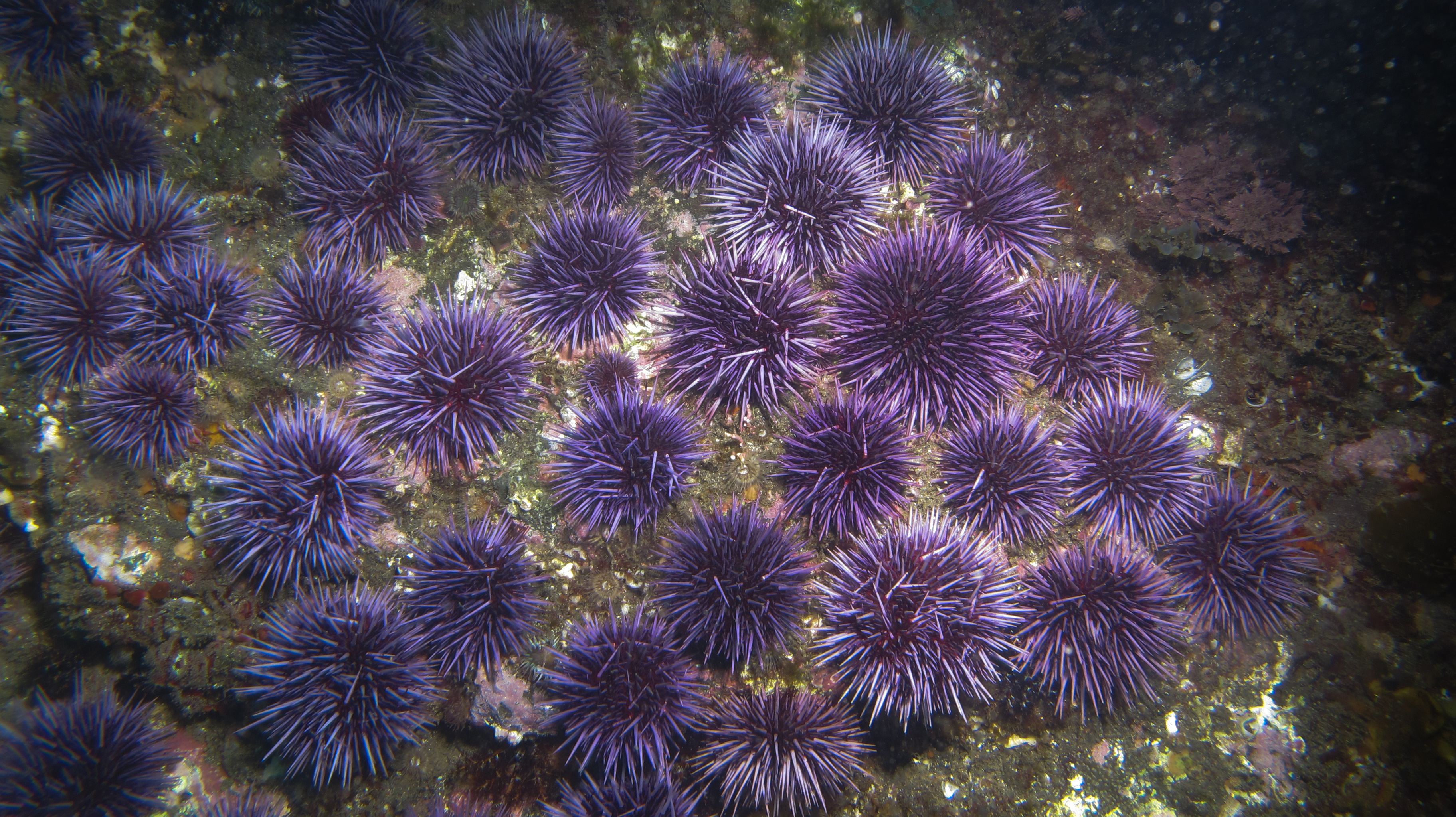Urchin barren on:
[Wikipedia]
[Google]
[Amazon]
 An urchin barren is an area of the shallow part of the ocean where the population growth of
An urchin barren is an area of the shallow part of the ocean where the population growth of
 An urchin barren is an area of the shallow part of the ocean where the population growth of
An urchin barren is an area of the shallow part of the ocean where the population growth of sea urchin
Sea urchins () are spiny, globular echinoderms in the class Echinoidea. About 950 species of sea urchin live on the seabed of every ocean and inhabit every depth zone from the intertidal seashore down to . The spherical, hard shells (tests) o ...
s has gone unchecked, causing destructive grazing
In agriculture, grazing is a method of animal husbandry whereby domestic livestock are allowed outdoors to roam around and consume wild vegetations in order to convert the otherwise indigestible (by human gut) cellulose within grass and ot ...
of kelp forest
Kelp forests are underwater areas with a high density of kelp, which covers a large part of the world's coastlines. Smaller areas of anchored kelp are called kelp beds. They are recognized as one of the most productive and dynamic ecosystems on Ea ...
s.
Process
Sea urchins eat kelp holdfasts. This can be caused by a lack ofsea otter
The sea otter (''Enhydra lutris'') is a marine mammal native to the coasts of the northern and eastern North Pacific Ocean. Adult sea otters typically weigh between , making them the heaviest members of the weasel family, but among the smal ...
s or other predators in the area, which makes it extremely important to protect the ecological balance in a kelp forest. Keystone species
A keystone species is a species which has a disproportionately large effect on its natural environment relative to its abundance, a concept introduced in 1969 by the zoologist Robert T. Paine. Keystone species play a critical role in maintaini ...
such as the sea otter help maintain healthy kelp communities; however, likely because of increased killer whale predation, their numbers are in decline in areas of Western Alaska. Off the California coast, storm runoff, erosion and polluted water allow less light to penetrate, weakening the kelp. Sea urchins then can move in and settle.
Despite their name, urchin barrens are usually abundant with marine invertebrate life, echinoderms
An echinoderm () is any member of the phylum Echinodermata (). The adults are recognisable by their (usually five-point) radial symmetry, and include starfish, brittle stars, sea urchins, sand dollars, and sea cucumbers, as well as the ...
in particular. Species such as the sunflower starfishes, brittle stars, and the purple sea urchin
''Strongylocentrotus purpuratus'', the purple sea urchin, lives along the eastern edge of the Pacific Ocean extending from Ensenada, Mexico, to British Columbia, Canada. This sea urchin species is deep purple in color, and lives in lower int ...
are common. Although macrofauna such as these are aplenty, there is little primary productivity among microorganisms. This makes it difficult for newly settled sea urchins (juveniles) to survive, making barrens more dangerous for juveniles than for adults. Once having wiped out a kelp forest, the environment becomes unsupportive of new sea urchin settlement and adults are forced to find a new resource.
Shift theories
An area of the subtidal where the population growth of sea urchins has gone unchecked causes destructive grazing of kelp beds or kelp forests (specifically the giant brown bladder kelp, ''Macrocystis
''Macrocystis'' is a monospecific genus of kelp (large brown algae). This genus contains the largest of all the phaeophyceae or brown algae. ''Macrocystis'' has pneumatocysts at the base of its blades. Sporophytes are perennial and the indi ...
''). The transition from kelp forest to barren is defined by phase shifts in which one stable community state is shifted to another. The continuous phase shift is widely accepted. This describes a transition from one ecosystem state to another where the threshold for the forward shift is at the same level as the threshold for the reverse shift back to the previous state. In other words, a kelp bed can re-establish itself when urchin grazing intensity decreases to the threshold density triggering the initial shift.
Alternatively, another theory posits that both sea urchin barrens and kelp-beds represent alternative stable states, meaning that an ecosystem can exist under multiple states, each with a set of unique biotic and abiotic conditions (i.e. barren except for urchins or flourishing with kelp). Those who argue for this theory propose several criteria: that different self-replacing communities dominate the site; each state exists longer than one complete turnover of the dominant community or species; and that following a disturbance (e.g. a storm), the system returns to the previous state.
Impacted areas
Over the past four decades, barrens have been reported along coastlines around the world, everywhere from Nova Scotia to Chile. They can either span over a thousand kilometers of coastline or occur in small patches.References
Aquatic ecology Echinoidea {{Ocean-stub